Abstract
Down syndrome (DS) is a major cause of mental retardation and congenital heart disease. Besides a characteristic set of facial and physical features, DS is associated with congenital anomalies of the gastrointestinal tract, an increased risk of leukemia, immune system defects, and an Alzheimer-like dementia. Moreover, DS is a model for the study of human aneuploidy. Although usually caused by the presence of an extra chromosome 21, subsets of the phenotypic features of DS may be caused by the duplication of small regions of the chromosome. The physical map of chromosome 21 allows the molecular definition of the regions duplicated in these rare cases of partial trisomy. As a first step in identifying the genes responsible for individual DS features and their pathophysiology, a panel of cell lines derived from 16 such individuals has been established and the molecular break points have been determined using fluorescence in situ hybridization and Southern blot dosage analysis of 32 markers unique to human chromosome 21. Combining this information with detailed clinical evaluations of these patients, we have now constructed a "phenotypic map" that includes 25 features and assigns regions of 2-20 megabases as likely to contain the genes responsible. This study provides evidence for a significant contribution of genes outside the D21S55 region to the DS phenotypes, including the facies, microcephaly, short stature, hypotonia, abnormal dermatoglyphics, and mental retardation. This strongly suggests DS is a contiguous gene syndrome and augurs against a single DS chromosomal region responsible for most of the DS phenotypic features.
Full text
PDF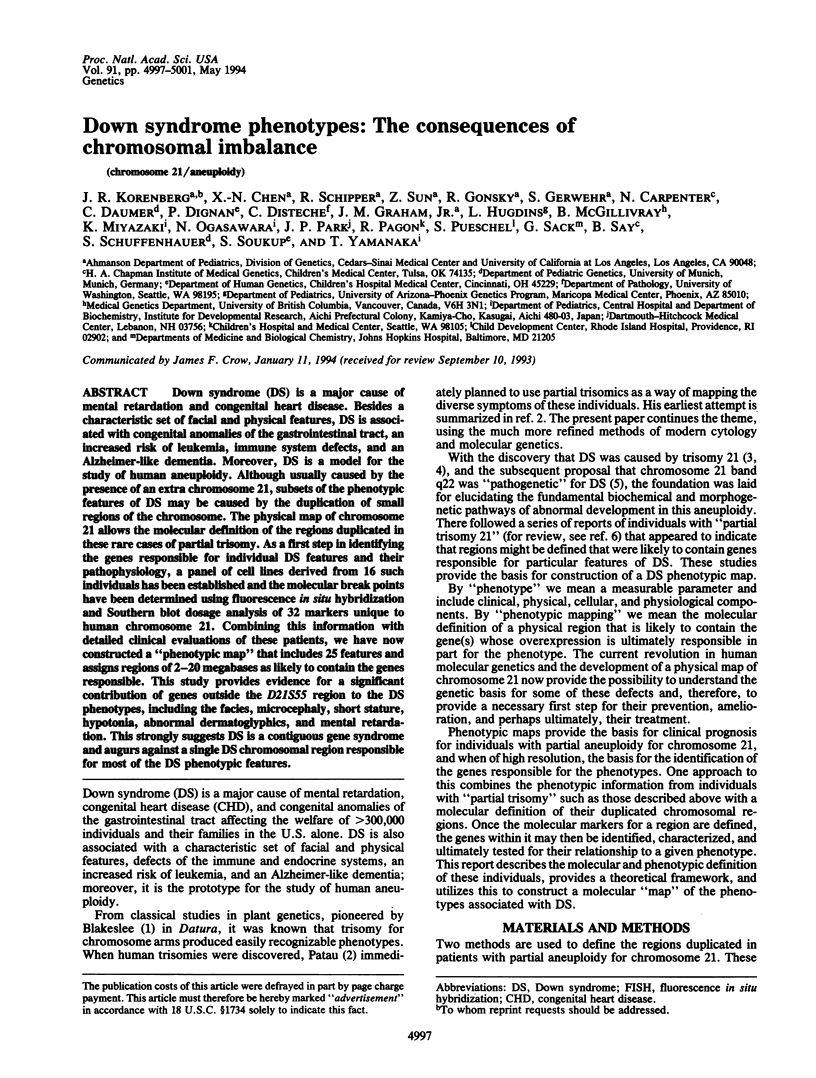
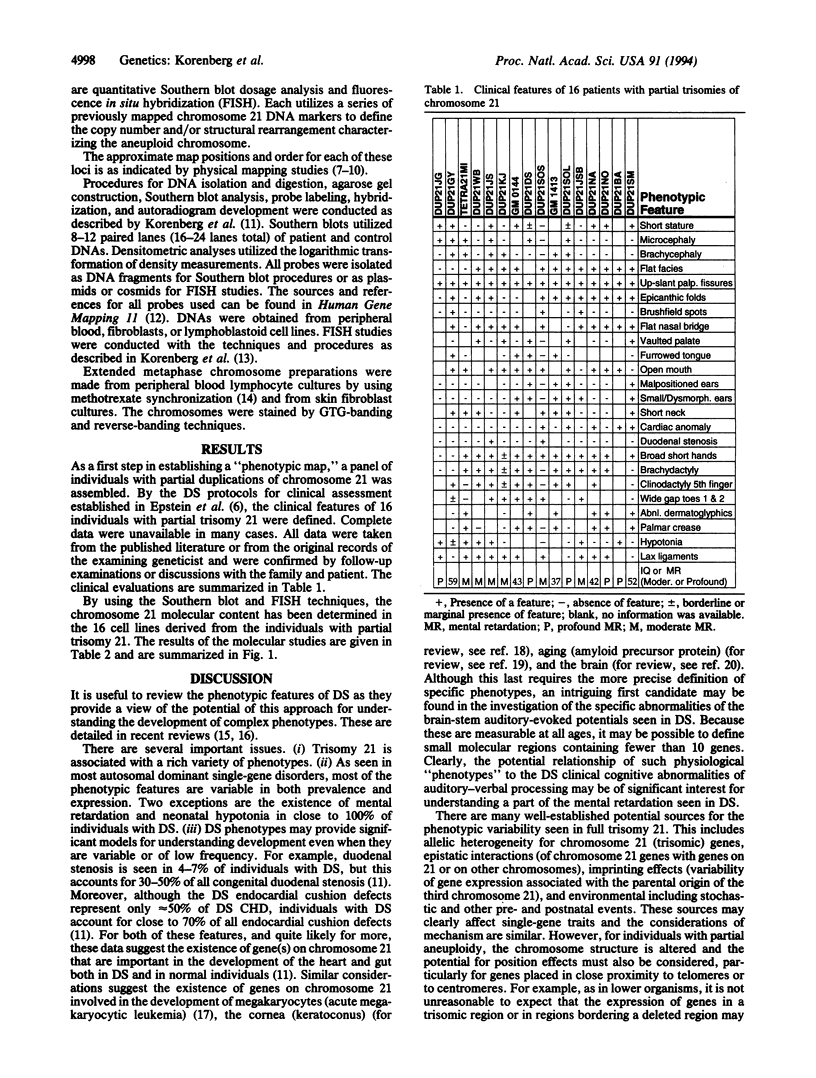
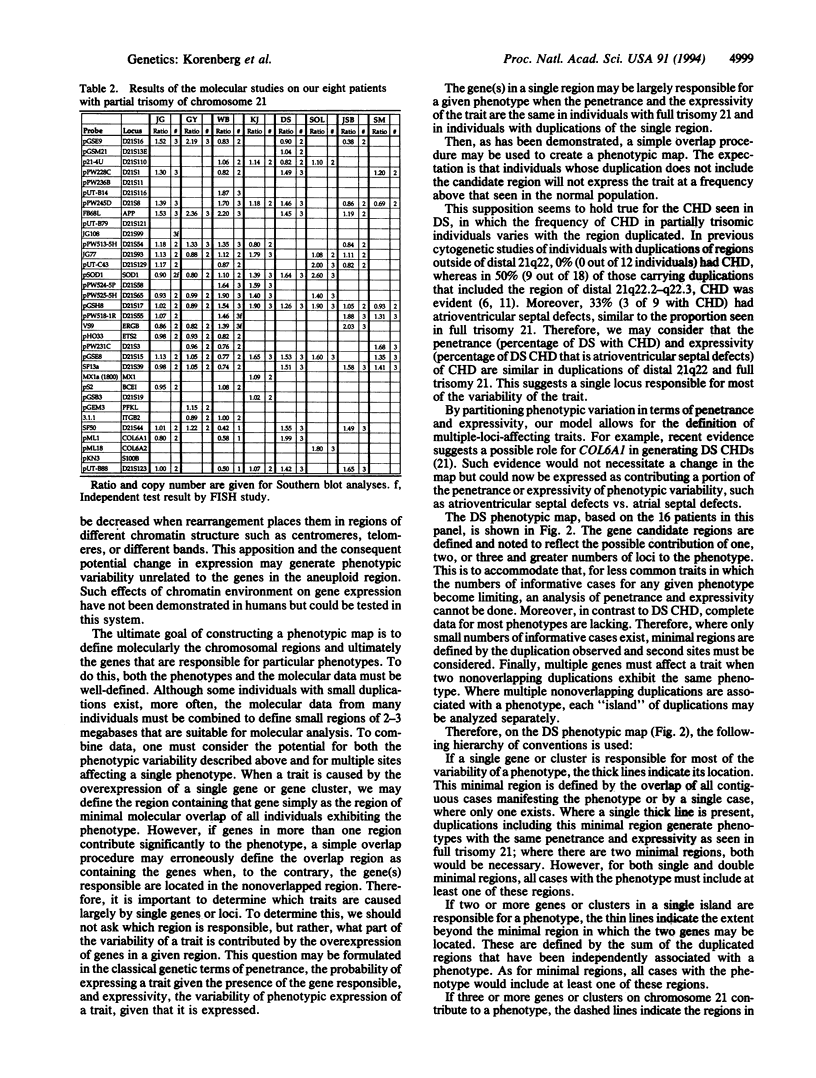
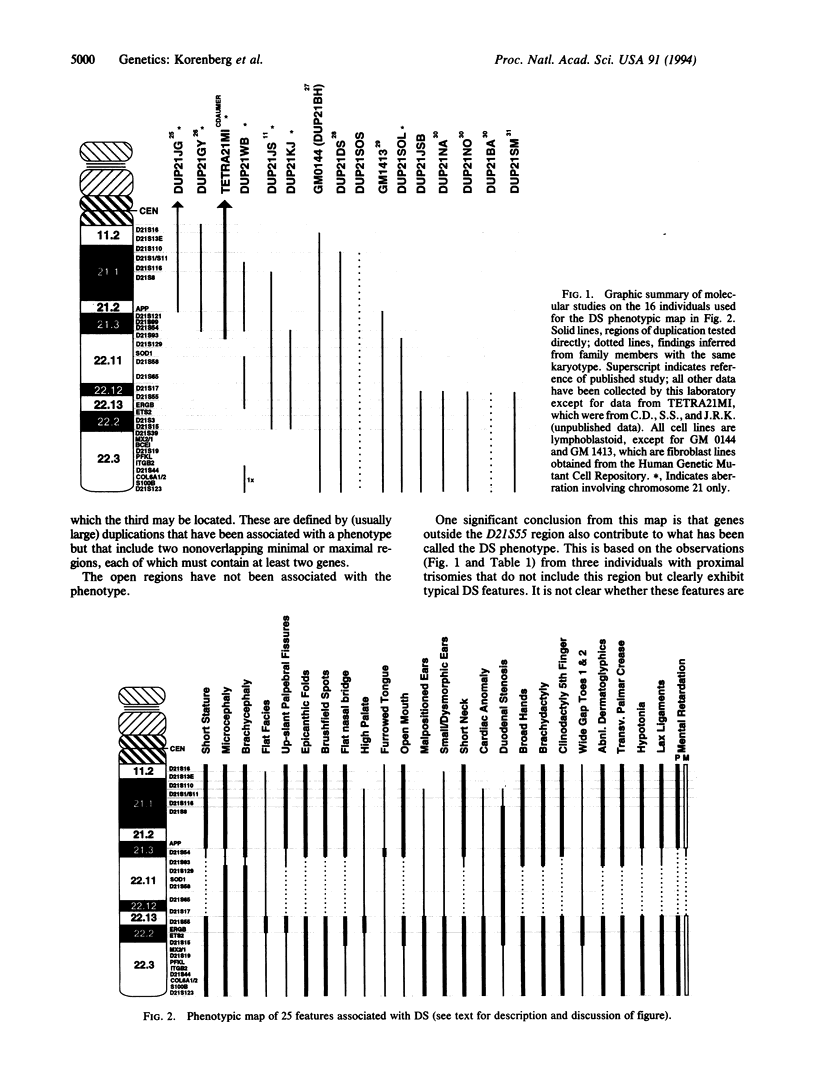
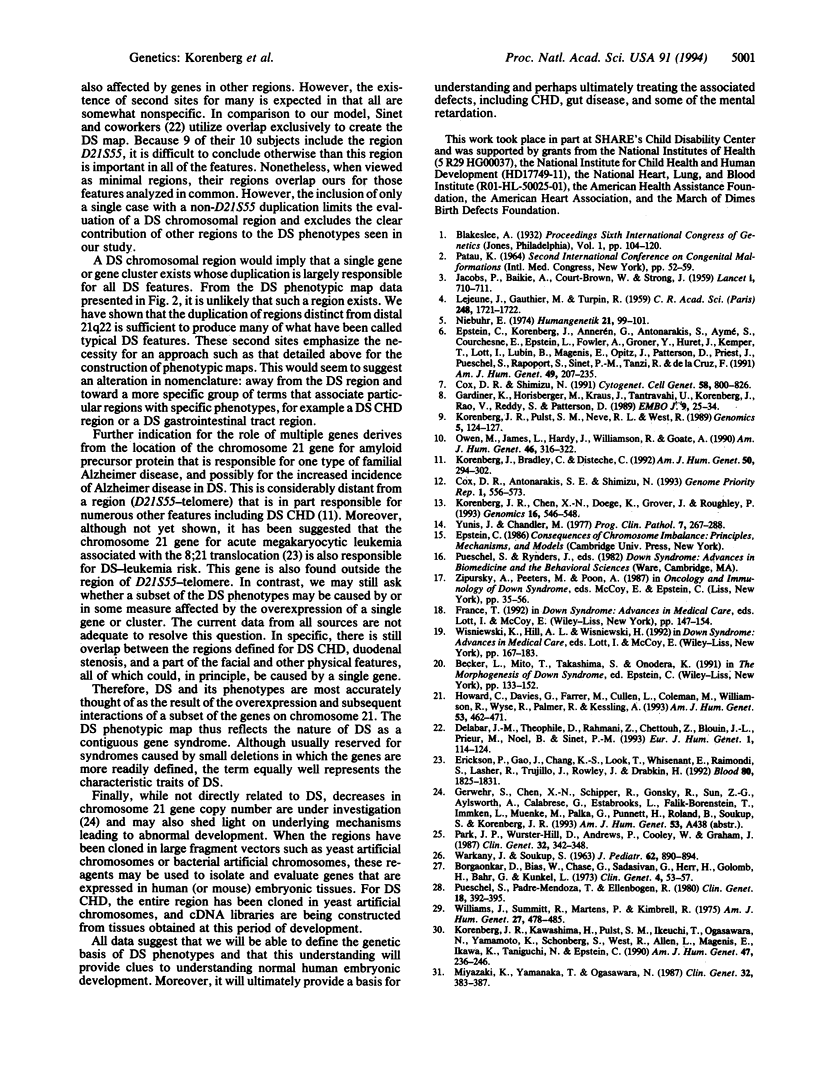
Selected References
These references are in PubMed. This may not be the complete list of references from this article.
- Becker L., Mito T., Takashima S., Onodera K. Growth and development of the brain in Down syndrome. Prog Clin Biol Res. 1991;373:133–152. [PubMed] [Google Scholar]
- Borgaonkar D. S., Bias W. B., Chase G. A., Sadasivan G., Herr H. M., Golomb H. M., Bahr G. F., Kunkel L. M. Identification of a C6-G21 translocation chromosome by the Q-M and Giemsa banding techniques in a patient with Down's syndrome, with possible assignment of Gm locus. Clin Genet. 1973;4(1):53–57. doi: 10.1111/j.1399-0004.1973.tb01122.x. [DOI] [PubMed] [Google Scholar]
- Delabar J. M., Theophile D., Rahmani Z., Chettouh Z., Blouin J. L., Prieur M., Noel B., Sinet P. M. Molecular mapping of twenty-four features of Down syndrome on chromosome 21. Eur J Hum Genet. 1993;1(2):114–124. doi: 10.1159/000472398. [DOI] [PubMed] [Google Scholar]
- Erickson P., Gao J., Chang K. S., Look T., Whisenant E., Raimondi S., Lasher R., Trujillo J., Rowley J., Drabkin H. Identification of breakpoints in t(8;21) acute myelogenous leukemia and isolation of a fusion transcript, AML1/ETO, with similarity to Drosophila segmentation gene, runt. Blood. 1992 Oct 1;80(7):1825–1831. [PubMed] [Google Scholar]
- Howard C. M., Davies G. E., Farrer M. J., Cullen L. M., Coleman M. M., Williamson R., Wyse R. K., Palmer R., Kessling A. M. Meiotic crossing-over in nondisjoined chromosomes of children with trisomy 21 and a congenital heart defect. Am J Hum Genet. 1993 Aug;53(2):462–471. [PMC free article] [PubMed] [Google Scholar]
- JACOBS P. A., BAIKIE A. G., COURT BROWN W. M., STRONG J. A. The somatic chromosomes in mongolism. Lancet. 1959 Apr 4;1(7075):710–710. doi: 10.1016/s0140-6736(59)91892-6. [DOI] [PubMed] [Google Scholar]
- Korenberg J. R., Bradley C., Disteche C. M. Down syndrome: molecular mapping of the congenital heart disease and duodenal stenosis. Am J Hum Genet. 1992 Feb;50(2):294–302. [PMC free article] [PubMed] [Google Scholar]
- Korenberg J. R., Chen X. N., Doege K., Grover J., Roughley P. J. Assignment of the human aggrecan gene (AGC1) to 15q26 using fluorescence in situ hybridization analysis. Genomics. 1993 May;16(2):546–548. doi: 10.1006/geno.1993.1228. [DOI] [PubMed] [Google Scholar]
- Korenberg J. R., Kawashima H., Pulst S. M., Ikeuchi T., Ogasawara N., Yamamoto K., Schonberg S. A., West R., Allen L., Magenis E. Molecular definition of a region of chromosome 21 that causes features of the Down syndrome phenotype. Am J Hum Genet. 1990 Aug;47(2):236–246. [PMC free article] [PubMed] [Google Scholar]
- Korenberg J. R., Pulst S. M., Neve R. L., West R. The Alzheimer amyloid precursor protein maps to human chromosome 21 bands q21.105-q21.05. Genomics. 1989 Jul;5(1):124–127. doi: 10.1016/0888-7543(89)90095-5. [DOI] [PubMed] [Google Scholar]
- LEJEUNE J., GAUTIER M., TURPIN R. Etude des chromosomes somatiques de neuf enfants mongoliens. C R Hebd Seances Acad Sci. 1959 Mar 16;248(11):1721–1722. [PubMed] [Google Scholar]
- Miyazaki K., Yamanaka T., Ogasawara N. A boy with Down's syndrome having recombinant chromosome 21 but no SOD-1 excess. Clin Genet. 1987 Dec;32(6):383–387. doi: 10.1111/j.1399-0004.1987.tb03154.x. [DOI] [PubMed] [Google Scholar]
- Niebuhr E. Down's syndrome. The possibility of a pathogenetic segment on chromosome no. 21. Humangenetik. 1974 Jan 22;21(1):99–101. doi: 10.1007/BF00278575. [DOI] [PubMed] [Google Scholar]
- Owen M. J., James L. A., Hardy J. A., Williamson R., Goate A. M. Physical mapping around the Alzheimer disease locus on the proximal long arm of chromosome 21. Am J Hum Genet. 1990 Feb;46(2):316–322. [PMC free article] [PubMed] [Google Scholar]
- Park J. P., Wurster-Hill D. H., Andrews P. A., Cooley W. C., Graham J. M., Jr Free proximal trisomy 21 without the Down syndrome. Clin Genet. 1987 Nov;32(5):342–348. doi: 10.1111/j.1399-0004.1987.tb03299.x. [DOI] [PubMed] [Google Scholar]
- Pueschel S. M., Padre-Mendoza T., Ellenbogen R. Partial trisomy 21. Clin Genet. 1980 Nov;18(5):392–395. doi: 10.1111/j.1399-0004.1980.tb02300.x. [DOI] [PubMed] [Google Scholar]
- WARKANY J., SOUKUP S. W. A chromosomal abnormality in a girl with some features of Down's syndrome (mongolism). J Pediatr. 1963 Jun;62:890–894. doi: 10.1016/s0022-3476(63)80103-1. [DOI] [PubMed] [Google Scholar]
- Williams J. D., Summitt R. L., Martens P. R., Kimbrell R. A. Familial Down syndrome due to t(10;21) translocation: evidence that the Down phenotype is related to trisomy of a specific segment of chromosome 21. Am J Hum Genet. 1975 Jul;27(4):478–485. [PMC free article] [PubMed] [Google Scholar]
- Yunis J. J., Chandler M. E. High-resolution chromosome analysis in clinical medicine. Prog Clin Pathol. 1978;7:267–288. [PubMed] [Google Scholar]


